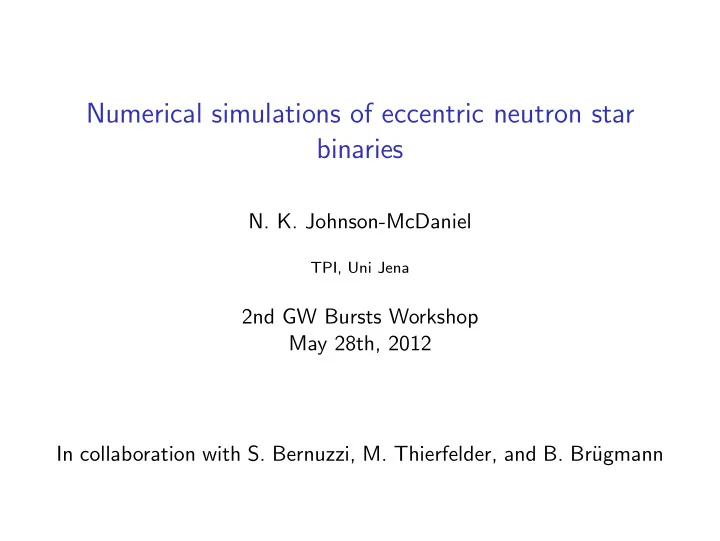

Numerical simulations of eccentric neutron star binaries N. K. Johnson-McDaniel TPI, Uni Jena 2nd GW Bursts Workshop May 28th, 2012 In collaboration with S. Bernuzzi, M. Thierfelder, and B. Br¨ ugmann
Why (highly) eccentric NS binaries? NR argument Another corner of parameter space to explore—and highly eccentric black hole binaries have already produced some intriguing results concerning. In addition, there is related work on highly eccentric BHNS binaries (East, Stephens, and Pretorius). ...but also GWs and astrophysics The signals from these binaries show an intriguing repeated burst structure, with inbetween oscillations due to tidal excitation of the neutron stars, making them of interest, even though they are likely rare events. See also work by J. Levin and collaborators on repeated bursts of GWs from eccentric binaries, mostly focussing on the black hole case, and work on detection involving V. Necula, S. Klimenko, and G. Mitselmakher, as well. ...and there has been general interest recently in the astrophysical processes that might form such highly eccentric systems (e.g., three-body interactions in dense stellar environments such as globular clusters of galactic cusps).
Why (highly) eccentric NS binaries? (cont.) There are also recent Newtonian SPH simulations of binary neutron star collisions by Rosswog et al. , focussing in particular on ejecta properties (e.g., for electromagnetic signatures and ISM enrichment). We are in a position to supplement these with fully relativistic simulations albeit with much less realistic microphysics .
Outline ◮ Computational setup ◮ Waveforms and visualizations—an overview of parameter space ◮ Accuracy studies ◮ SNRs ◮ Conclusions and where now?
Computational setup We use the BAM-Matter code with the general setup described by Sebastiano. The BAM code is very well advertised around Jena. Images courtesy of http://www.jenagraffiti.com
Computational setup (cont.) Initial data The initial data are constructed by superposing two boosted (Γ = 2 polytrope) TOV stars, and thus only approximately satisfies the constraints. However, the constraint violations are reasonably well-behaved during the evolution. Constraint satisfying initial data are currently being constructed by N. Moldenhauer and Ch. Markakis using a self-consistent field approach. Grids, resolution, etc. Most of our simulations of these systems to date have been relatively low-resolution runs with small grids, designed to shed some light on the parameter space. However, we have pushed one short run to quite high resolutions (finest grid spacings of 0 . 09375 M ⊙ and 0 . 0625 M ⊙ ), showing reasonably clean convergence (though only first order, and with a close outer boundary). Currently, we are looking at doing some higher-resolution convergence tests for other parameters (and also pushing out the outer boundary).
Waveforms for the (1 . 4 , 1 . 4) M ⊙ case (varying the initial boost) 0.01 0.008 0.006 p y = 0.045 p y = 0.0475 0.004 Re(r ψ 4 ) 0.002 0 -0.002 -0.004 -0.006 -0.008 -0.01 0 500 1000 1500 2000 0 500 1000 1500 2000 2500 3000 3500 t (solar masses) t (solar masses) 0.004 p y = 0.05 0.002 Re(r ψ 4 ) 0 -0.002 -0.004 -0.006 0 2000 4000 6000 8000 10000 t (solar masses)
Waveforms for the (1 . 3 , 1 . 3) M ⊙ case (varying both the initial boost and the initial separation 0.01 p y = 0.05, D =78 p y = 0.05, D = 82 0.005 Re(r ψ 4 ) 0 -0.005 0 1000 2000 0 1000 2000 500 1500 500 1500 t (solar masses) t (solar masses) 0.01 p y = 0.051, D = 80 p y = 0.049, D = 80 0.005 Re(r ψ 4 ) 0 -0.005 -0.01 0 500 1000 1500 2000 0 500 1000 1500 2000 t (solar masses) t (solar masses)
Some p y = 0 . 045 convergence results Convergence ratio Amplitude 3 2 1 0 Convergence ratio Phase 2 1 0 0.004 0.002 Re(r ψ 4 ) 0.125 0.09375 0 0.0625 -0.002 -0.004 800 1000 1200 1400 1600 t (solar masses)
SNRs for ET for a few cases Rough SNRs for ET, considering an optimally oriented binary with various parameters at a fiducial distance of 200 Mpc. (Those for AdvLIGO are too small to worry about—at most ∼ 1.) For the (1 . 4 , 1 . 4) M ⊙ cases, the p y = 0 . 045 M ⊙ case has an SNR of ∼ 5, the p y = 0 . 0475 M ⊙ case has an SNR of ∼ 15, and the p y = 0 . 05 M ⊙ case has an SNR of ∼ 30, of which � 1 is due to the inter-burst oscillations. All of the (1 . 3 , 1 . 3) M ⊙ cases shown have SNRs of ∼ 5. But these numbers don’t tell us much—they’re matched filtering SNRs, and one is not going to detect these systems with matched filtering: One really needs to run a burst detection algorithm on the waveforms...
Conclusions—and where now? ◮ We have started to firm up the predictions of our simulations of eccentric neutron star binaries, with particular reference to the tidally-induced oscillations we observe. ◮ We find relatively clean first-order convergence in a short test case. ◮ The parameter space is quite interesting, with strong dependence of qualitative features on initial conditions. NR items ◮ Assess convergence of more configurations, including ones with oscillations. (These simulations will also have a much further out outer boundary, and will extrapolate the waves to infinity.) ◮ Use constraint-satisfying initial data. ◮ Investigate the relationship between the observed oscillations and stellar perturbation theory predictions (of frequency and amplitude).
Conclusions—and where now? (cont.) Astro items ◮ Treat more realistic configurations—e.g., a more realistic EOS (real microphysics and a realistic maximum mass), plus unequal masses. ◮ Look more carefully at GW detectability, particularly of the oscillations. ◮ Consider the properties of the final remnant and ejecta vis-´ a-vis electromagnetic signatures (e.g., GRBs) and general accretion physics.
Recommend
More recommend